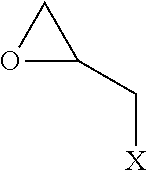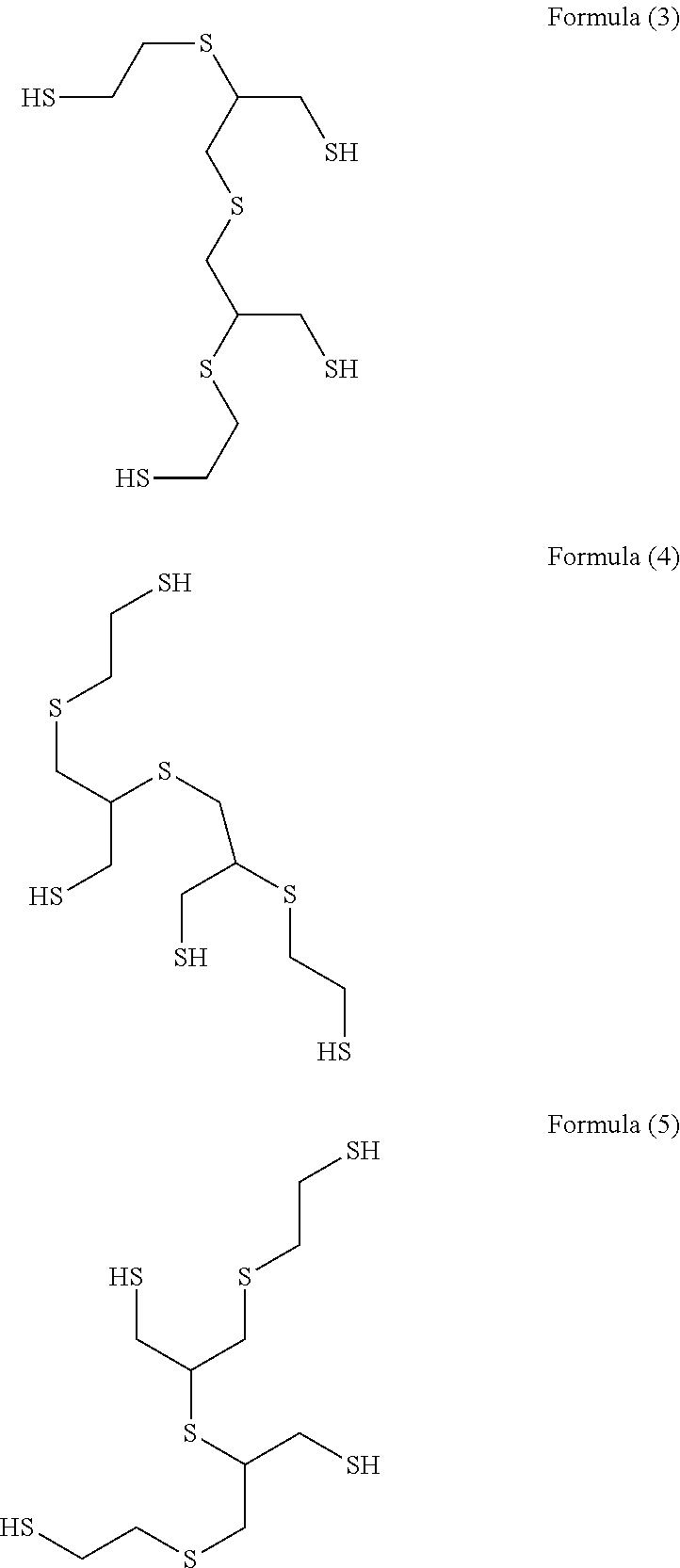Method for producing polythiol compound, method for producing curable composition, and method for producing cured product
a polythiourethane resin and composition technology, applied in the direction of hydropoly/poly sulfide preparation, sulfide preparation, instruments, etc., can solve the problems of large decrease in heat resistance, difficult to improve the tensile strength of polythiourethane resin, and high cost, so as to achieve the effect of reducing heat resistan
- Summary
- Abstract
- Description
- Claims
- Application Information
AI Technical Summary
Benefits of technology
Problems solved by technology
Method used
Image
Examples
scheme example 1
Reaction Scheme Example 1
[0037]
[0038]In the epihalohydrin and in Formula (1), X represents a halogen atom. For example, by using epichlorohydrin (X=chlorine atom) as the epihalohydrin in Step 1A, a polyol compound in which X in Formula (1) is a chlorine atom can be obtained. Further, by using epibromohydrin (X=bromine atom) as the epihalohydrin in Step 1A, a polyol compound in which X in Formula (1) is a bromine atom can be obtained. The details relating to the halogen atom contained in the epihalohydrin are as described hereinabove. The same applies to the halogen atom represented by X included in Formula (1). In Aspect A, Step 1A is carried out in the presence of a halide selected from the group consisting of a 2,3-dihalogeno-1-propanol and an allyl halide, the amount of the halide being more than 0.50% by mass and 10.00% by mass or less with respect to the total amount with the epihalohydrin. Details relating to the amount of the halide in Step 1A are as described hereinabove.
[00...
scheme example 2
Reaction Scheme Example 2
[0045]
[0046]After the reaction of Step 1A, the reaction solution including the target substance obtained by the reaction may be used as it is in Step 2A, but the reaction solution after the reaction in Step 1A may be also purified by a known method to isolate the target substance or increase the concentration thereof and then used in the next step. Alternatively, the reaction solution after the reaction in Step 1A can be diluted with a solvent (for example, toluene and the like) and then used in the next step. The above considerations are also applicable to stages after various below-described reactions.
[0047]The abovementioned Reaction Scheme Example 2 relates to an example in which the alkali metal atom contained in the alkali metal sulfide is a sodium atom. However, the alkali metal atom contained in the alkali metal sulfide may be another alkali metal atom such as a lithium atom and a potassium atom. The alkali metal sulfide can be reacted with the polyo...
scheme example 3
Reaction Scheme Example 3
[0050]
[0051]In the Reaction Scheme Example 3, an example is shown in which hydrogen chloride (HCl) is used as an acid, but the acid used in Step 3A is not limited to hydrogen chloride, and various inorganic acids and organic acids can be used. Examples of the inorganic acids include hydrogen chloride, sulfuric acid and the like, and examples of organic acids include formic acid and the like. The form of addition of an acid is not limited, and the acid can be added, for example, as an aqueous solution. The concentration of the acid in the aqueous solution is not particularly limited, and can be, for example, about 10% by mass to 80% by mass. In Step 3A, the acid can be used at a ratio of, for example, 2.0 mol to 12.0 mol, or 3.0 mol to 8.0 mol, and thiourea can be used at a ratio of, for example, 3.0 mol to 6.0 mole, or 4.5 mol to 5.5 mol with respect to 1.0 mol of the polyol compound represented by Formula (2). The reaction temperature in Step 3A can be, for...
PUM
| Property | Measurement | Unit |
|---|---|---|
| reaction temperature | aaaaa | aaaaa |
| temperature | aaaaa | aaaaa |
| temperature | aaaaa | aaaaa |
Abstract
Description
Claims
Application Information
 Login to View More
Login to View More - R&D
- Intellectual Property
- Life Sciences
- Materials
- Tech Scout
- Unparalleled Data Quality
- Higher Quality Content
- 60% Fewer Hallucinations
Browse by: Latest US Patents, China's latest patents, Technical Efficacy Thesaurus, Application Domain, Technology Topic, Popular Technical Reports.
© 2025 PatSnap. All rights reserved.Legal|Privacy policy|Modern Slavery Act Transparency Statement|Sitemap|About US| Contact US: help@patsnap.com



